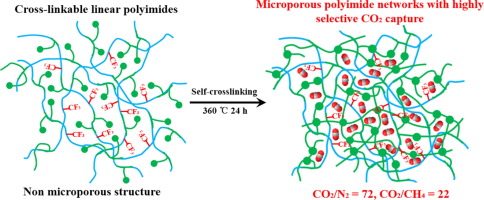当前位置:
X-MOL 学术
›
J. Colloid Interface Sci.
›
论文详情
Our official English website, www.x-mol.net, welcomes your feedback! (Note: you will need to create a separate account there.)
Microporous polyimides with high surface area and CO2 selectivity fabricated from cross-linkable linear polyimides.
Journal of Colloid and Interface Science ( IF 9.9 ) Pub Date : 2020-03-31 , DOI: 10.1016/j.jcis.2020.03.113 Ningning Song 1 , Tengning Ma 2 , Tianjiao Wang 1 , Zhenghua Li 3 , Hongyan Yao 1 , Shaowei Guan 1
Journal of Colloid and Interface Science ( IF 9.9 ) Pub Date : 2020-03-31 , DOI: 10.1016/j.jcis.2020.03.113 Ningning Song 1 , Tengning Ma 2 , Tianjiao Wang 1 , Zhenghua Li 3 , Hongyan Yao 1 , Shaowei Guan 1
Affiliation

|
Linear polyimides of intrinsic microporosity have been intensively investigated for gas separation due to their microporous structure and high surface area. The microporous structure in the linear polyimides of intrinsic microporosity comes from their contorted structure. Therefore, most linear polyimides without contorted structure do not have micropores. In this work, the microporous polyimides are constructed through the condensation of a cross-linkable dianhydride monomer with two novel nitrogen-rich diamine monomers and post crosslinking reaction. The linear polyimide precursors without contorted structure have the same main-chain structure. The introduction of crosslinked structure endow the crosslinked polyimides (PI-CLs) with microporous structure. The microporous structure in PI-CLs can be tuned by changing the substituents of the linear polyimide precursors. The PI-CLs have competitive CO2 uptake capacity (7.3-9.4 wt%) at 273 K and 1 bar. Particularly, the crosslinked polyimide containing trifluoromethyl groups (CF3-PI-CL) shows high CO2/N2 and CO2/CH4 selectivity (72 and 22) at 273 K, which are among the best results for reported porous materials. This work reveals that the introduction of crosslinked structure and changing substituents is an efficient method for constructing microporous polyimides with abundant micropores and excellent CO2 selective adsorption capacity. This method also has great potential for fabricating high-performance microporous polymers based on other linear polymers without rigid contorted structure.
中文翻译:

由可交联的线性聚酰亚胺制成的具有高表面积和CO2选择性的微孔聚酰亚胺。
固有的微孔性的线性聚酰亚胺由于其微孔结构和高表面积已被广泛研究用于气体分离。固有的微孔性的线性聚酰亚胺中的微孔结构来自其扭曲的结构。因此,大多数没有扭曲结构的线性聚酰亚胺没有微孔。在这项工作中,微孔聚酰亚胺是通过使可交联的二酐单体与两种新型的富氮二胺单体缩合并进行后交联反应而构建的。没有扭曲结构的线性聚酰亚胺前体具有相同的主链结构。交联结构的引入使交联聚酰亚胺(PI-CLs)具有微孔结构。PI-CL中的微孔结构可以通过改变线性聚酰亚胺前体的取代基来调节。PI-CL在273 K和1 bar下具有极好的二氧化碳吸收能力(7.3-9.4 wt%)。特别是,含有三氟甲基的交联聚酰亚胺(CF3-PI-CL)在273 K时显示出高的CO2 / N2和CO2 / CH4选择性(72和22),这是所报道的多孔材料的最佳结果。这项工作表明,引入交联结构和改变取代基是一种构建具有丰富微孔和出色的CO2选择性吸附能力的微孔聚酰亚胺的有效方法。该方法在基于没有刚性扭曲结构的其他线性聚合物的高性能微孔聚合物的制造中也具有很大的潜力。PI-CL在273 K和1 bar下具有极好的二氧化碳吸收能力(7.3-9.4 wt%)。特别是,含有三氟甲基的交联聚酰亚胺(CF3-PI-CL)在273 K时显示出高的CO2 / N2和CO2 / CH4选择性(72和22),这是所报道的多孔材料的最佳结果。这项工作表明,引入交联结构和改变取代基是一种构建具有丰富微孔和出色的CO2选择性吸附能力的微孔聚酰亚胺的有效方法。该方法在基于没有刚性扭曲结构的其他线性聚合物的高性能微孔聚合物的制造中也具有很大的潜力。PI-CL在273 K和1 bar下具有极好的二氧化碳吸收能力(7.3-9.4 wt%)。特别是,含有三氟甲基的交联聚酰亚胺(CF3-PI-CL)在273 K时显示出高的CO2 / N2和CO2 / CH4选择性(72和22),这是所报道的多孔材料的最佳结果。这项工作表明,引入交联结构和改变取代基是一种构建具有丰富微孔和出色的CO2选择性吸附能力的微孔聚酰亚胺的有效方法。该方法在基于没有刚性扭曲结构的其他线性聚合物的高性能微孔聚合物的制造中也具有很大的潜力。含有三氟甲基的交联聚酰亚胺(CF3-PI-CL)在273 K时显示出高的CO2 / N2和CO2 / CH4选择性(72和22),这是所报道的多孔材料的最佳结果。这项工作表明,引入交联结构和改变取代基是一种构建具有丰富微孔和出色的CO2选择性吸附能力的微孔聚酰亚胺的有效方法。该方法在基于没有刚性扭曲结构的其他线性聚合物的高性能微孔聚合物的制造中也具有很大的潜力。含有三氟甲基的交联聚酰亚胺(CF3-PI-CL)在273 K时显示出高的CO2 / N2和CO2 / CH4选择性(72和22),这是所报道的多孔材料的最佳结果。这项工作表明,引入交联结构和改变取代基是一种构建具有丰富微孔和出色的CO2选择性吸附能力的微孔聚酰亚胺的有效方法。该方法在基于没有刚性扭曲结构的其他线性聚合物的高性能微孔聚合物的制造中也具有很大的潜力。这项工作表明,引入交联结构和改变取代基是一种构建具有丰富微孔和出色的CO2选择性吸附能力的微孔聚酰亚胺的有效方法。该方法在基于没有刚性扭曲结构的其他线性聚合物的高性能微孔聚合物的制造中也具有很大的潜力。这项工作表明,引入交联结构和改变取代基是一种构建具有丰富微孔和出色的CO2选择性吸附能力的微孔聚酰亚胺的有效方法。该方法在基于没有刚性扭曲结构的其他线性聚合物的高性能微孔聚合物的制造中也具有很大的潜力。
更新日期:2020-03-31
中文翻译:

由可交联的线性聚酰亚胺制成的具有高表面积和CO2选择性的微孔聚酰亚胺。
固有的微孔性的线性聚酰亚胺由于其微孔结构和高表面积已被广泛研究用于气体分离。固有的微孔性的线性聚酰亚胺中的微孔结构来自其扭曲的结构。因此,大多数没有扭曲结构的线性聚酰亚胺没有微孔。在这项工作中,微孔聚酰亚胺是通过使可交联的二酐单体与两种新型的富氮二胺单体缩合并进行后交联反应而构建的。没有扭曲结构的线性聚酰亚胺前体具有相同的主链结构。交联结构的引入使交联聚酰亚胺(PI-CLs)具有微孔结构。PI-CL中的微孔结构可以通过改变线性聚酰亚胺前体的取代基来调节。PI-CL在273 K和1 bar下具有极好的二氧化碳吸收能力(7.3-9.4 wt%)。特别是,含有三氟甲基的交联聚酰亚胺(CF3-PI-CL)在273 K时显示出高的CO2 / N2和CO2 / CH4选择性(72和22),这是所报道的多孔材料的最佳结果。这项工作表明,引入交联结构和改变取代基是一种构建具有丰富微孔和出色的CO2选择性吸附能力的微孔聚酰亚胺的有效方法。该方法在基于没有刚性扭曲结构的其他线性聚合物的高性能微孔聚合物的制造中也具有很大的潜力。PI-CL在273 K和1 bar下具有极好的二氧化碳吸收能力(7.3-9.4 wt%)。特别是,含有三氟甲基的交联聚酰亚胺(CF3-PI-CL)在273 K时显示出高的CO2 / N2和CO2 / CH4选择性(72和22),这是所报道的多孔材料的最佳结果。这项工作表明,引入交联结构和改变取代基是一种构建具有丰富微孔和出色的CO2选择性吸附能力的微孔聚酰亚胺的有效方法。该方法在基于没有刚性扭曲结构的其他线性聚合物的高性能微孔聚合物的制造中也具有很大的潜力。PI-CL在273 K和1 bar下具有极好的二氧化碳吸收能力(7.3-9.4 wt%)。特别是,含有三氟甲基的交联聚酰亚胺(CF3-PI-CL)在273 K时显示出高的CO2 / N2和CO2 / CH4选择性(72和22),这是所报道的多孔材料的最佳结果。这项工作表明,引入交联结构和改变取代基是一种构建具有丰富微孔和出色的CO2选择性吸附能力的微孔聚酰亚胺的有效方法。该方法在基于没有刚性扭曲结构的其他线性聚合物的高性能微孔聚合物的制造中也具有很大的潜力。含有三氟甲基的交联聚酰亚胺(CF3-PI-CL)在273 K时显示出高的CO2 / N2和CO2 / CH4选择性(72和22),这是所报道的多孔材料的最佳结果。这项工作表明,引入交联结构和改变取代基是一种构建具有丰富微孔和出色的CO2选择性吸附能力的微孔聚酰亚胺的有效方法。该方法在基于没有刚性扭曲结构的其他线性聚合物的高性能微孔聚合物的制造中也具有很大的潜力。含有三氟甲基的交联聚酰亚胺(CF3-PI-CL)在273 K时显示出高的CO2 / N2和CO2 / CH4选择性(72和22),这是所报道的多孔材料的最佳结果。这项工作表明,引入交联结构和改变取代基是一种构建具有丰富微孔和出色的CO2选择性吸附能力的微孔聚酰亚胺的有效方法。该方法在基于没有刚性扭曲结构的其他线性聚合物的高性能微孔聚合物的制造中也具有很大的潜力。这项工作表明,引入交联结构和改变取代基是一种构建具有丰富微孔和出色的CO2选择性吸附能力的微孔聚酰亚胺的有效方法。该方法在基于没有刚性扭曲结构的其他线性聚合物的高性能微孔聚合物的制造中也具有很大的潜力。这项工作表明,引入交联结构和改变取代基是一种构建具有丰富微孔和出色的CO2选择性吸附能力的微孔聚酰亚胺的有效方法。该方法在基于没有刚性扭曲结构的其他线性聚合物的高性能微孔聚合物的制造中也具有很大的潜力。


























 京公网安备 11010802027423号
京公网安备 11010802027423号